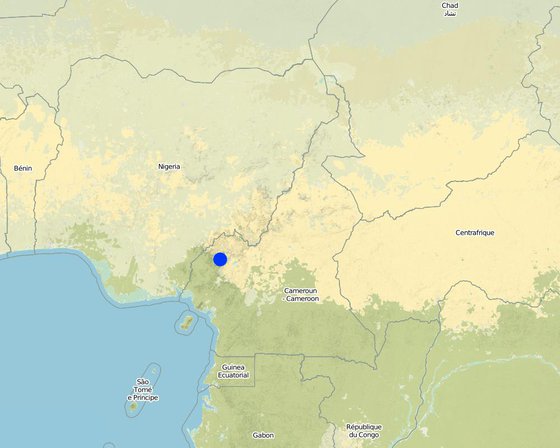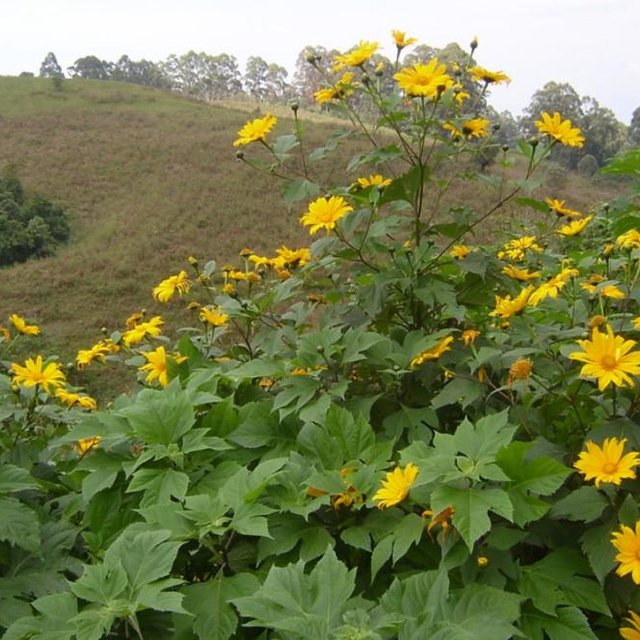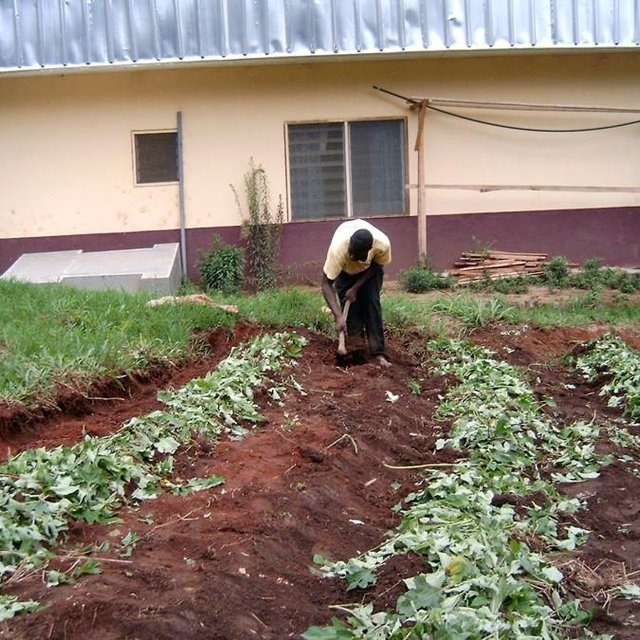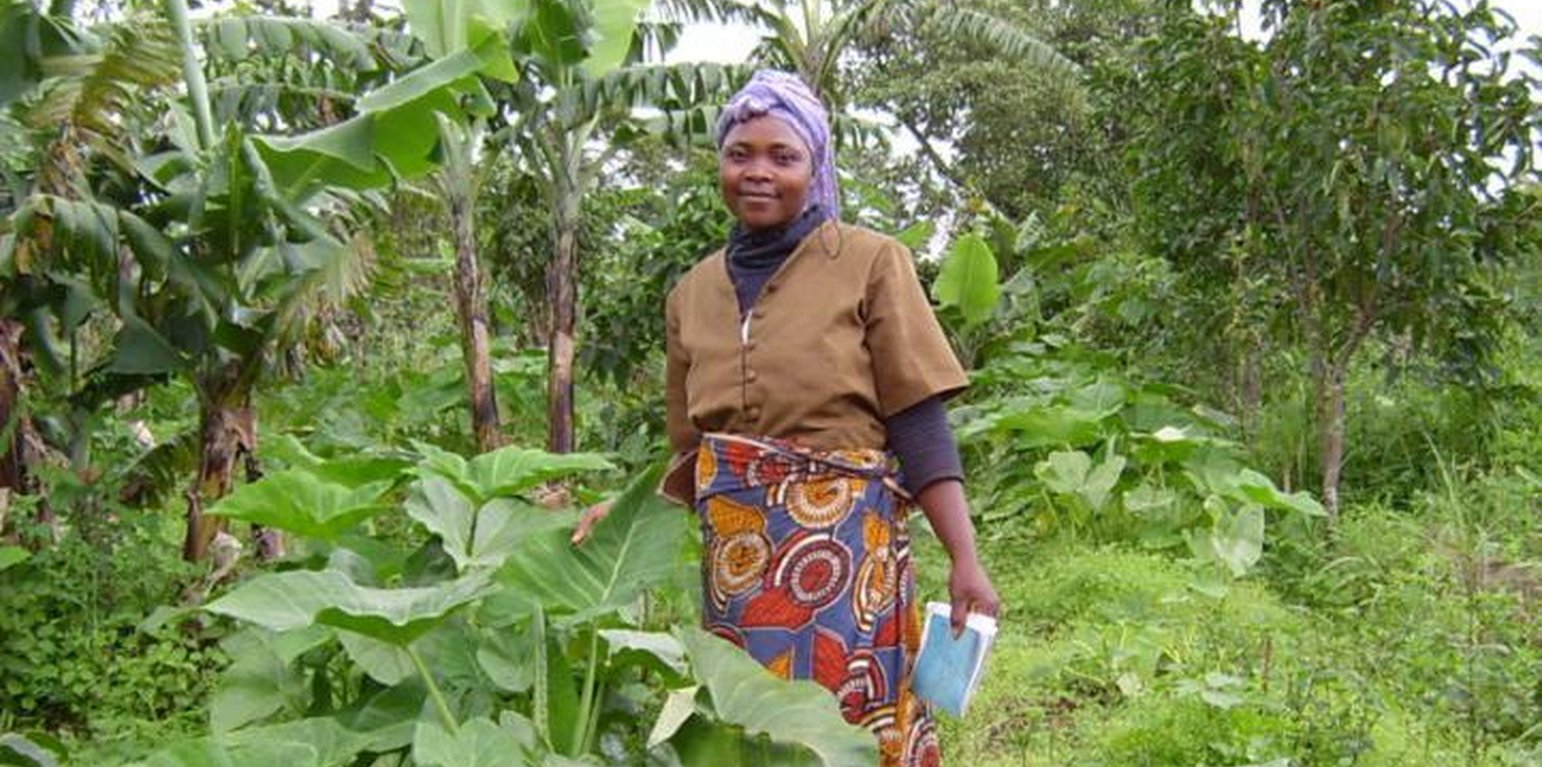Green manuring with Tithonia
(Cameroon)
Tithonia diversifolia (Mexican sunflower)
Description
Application of Tithonia diversifolia (Mexican sunflower) as green manure
Tithonia diversifolia hedges grow along roadsides or farm boundaries. The green leaf biomass is very suitable as green manure for annual crops, since the plant has a high content of nitrogen and phosphurus, and decomposes quickly after application to the soil: its nutrients are released within one growing season.
Purpose of the Technology: Tithonia biomass enhances soil organic matter and soil fertility, resulting in higher crop yields. The treatment supplies the crop with nutrients at the early stage of the growing process, and thus improves the establishment of the crops through the early development of a good rooting system. The technology is especially beneficial for maize: yields in the study area increased by over 50%.
Establishment / maintenance activities and inputs: At an early stage of plant growth, fresh green leaves and stems are cut, chopped and applied on the cropland as green manure after the first pass of ridging. The fresh material is spread over the half-made ridges at a ate of 2 kg per m2 and then covered with about 5-10 cm of soil to finish the ridges. Sowing of crop seeds is done only after a week or more, because of heat generation during the decomposition process of the leaves (which could damage the seeds).
Natural / human environment: Tithonia can also be applied as mulch 6 to 8 weeks after planting the crop. Covering the mulch with a little soil facilitates nutrient release. Tithonia green manuring - before planting - and mulching can be combined, which is especially applicable to maize, beans and cabbage cultivation. Tithonia hedgerows have to be cut back regularly; otherwise it can spread fast and become a weed. Interplanting Tithonia in the field is not recommended due to root competition with crops.
Location

Location: North-West Province, Akiri, Cameroon
No. of Technology sites analysed:
Geo-reference of selected sites
Spread of the Technology: evenly spread over an area (0.3 km²)
In a permanently protected area?:
Date of implementation: less than 10 years ago (recently)
Type of introduction
-
through land users' innovation
-
as part of a traditional system (> 50 years)
-
during experiments/ research
-
through projects/ external interventions

Hedge of Tithonia diversifolia, also known as Mexican sunflower (Fabienne Thomas (Swiss College of Agriculture SHL))

Supply of organic matter for mounds of the following growing season (Fabienne Thomas (Swiss College of Agriculture SHL))
Classification of the Technology
Main purpose
-
improve production
-
reduce, prevent, restore land degradation
-
conserve ecosystem
-
protect a watershed/ downstream areas – in combination with other Technologies
-
preserve/ improve biodiversity
-
reduce risk of disasters
-
adapt to climate change/ extremes and its impacts
-
mitigate climate change and its impacts
-
create beneficial economic impact
-
create beneficial social impact
Land use
Land use mixed within the same land unit: Yes - Agroforestry
-
Cropland
- Annual cropping: oilseed crops - groundnuts, cereals - maize, vegetables - leafy vegetables (salads, cabbage, spinach, other), legumes and pulses - beans, root/tuber crops - cassava, root/tuber crops - sweet potatoes, yams, taro/cocoyam, other, tomato
- Perennial (non-woody) cropping: banana/plantain/abaca
- Tree and shrub cropping: mango, mangosteen, guava, papaya, coffee
Number of growing seasons per year: 1
Water supply
-
rainfed
-
mixed rainfed-irrigated
-
full irrigation
Purpose related to land degradation
-
prevent land degradation
-
reduce land degradation
-
restore/ rehabilitate severely degraded land
-
adapt to land degradation
-
not applicable
Degradation addressed
-
chemical soil deterioration - Cn: fertility decline and reduced organic matter content (not caused by erosion)
SLM group
-
agroforestry
-
improved ground/ vegetation cover
-
integrated soil fertility management
SLM measures
-
agronomic measures - A2: Organic matter/ soil fertility
Technical drawing
Technical specifications
Establishment and maintenance: activities, inputs and costs
Calculation of inputs and costs
- Costs are calculated:
- Currency used for cost calculation: CFA
- Exchange rate (to USD): 1 USD = n.a CFA
- Average wage cost of hired labour per day: 3.00
Most important factors affecting the costs
Labour costs are the main factor affecting the costs. Labour inputs depend a lot on transport distance between Tithonia hedge and cropland.
Establishment activities
-
Planter Tithonia en bordure de propriété / champ / route (si elle ne pousse pas déjà naturellement) (Timing/ frequency: None)
Maintenance activities
-
Cut regularly Tithonia: trim hedges in the dry season (December / January) to ensure fresh regrowth to harvest from March to May (Timing/ frequency: Dry season (December / January))
-
Harvest the organic matter from the field and place it in the furrows of the last harvest which will become the mounds of the following crop in February (Timing/ frequency: February)
-
Harvest and chop green leaves and stems of Tithonia (Timing/ frequency: March to May)
-
Carry the fresh material to the farm and spread it on the half-made mounds and then cover with soil (Timing/ frequency: None)
-
Allow the green manure to decompose at least a week before sowing the crop (Timing/ frequency: None)
Maintenance inputs and costs
| Specify input |
Unit |
Quantity |
Costs per Unit (CFA) |
Total costs per input (CFA) |
% of costs borne by land users |
|
Labour
|
| Labour |
ha |
1.0 |
80.0 |
80.0 |
100.0 |
|
Equipment
|
| Tools |
ha |
1.0 |
30.0 |
30.0 |
100.0 |
| Total costs for maintenance of the Technology |
110.0 |
|
| Total costs for maintenance of the Technology in USD |
110.0 |
|
Natural environment
Average annual rainfall
-
< 250 mm
-
251-500 mm
-
501-750 mm
-
751-1,000 mm
-
1,001-1,500 mm
-
1,501-2,000 mm
-
2,001-3,000 mm
-
3,001-4,000 mm
-
> 4,000 mm
Agro-climatic zone
-
humid
-
sub-humid
-
semi-arid
-
arid
Specifications on climate
Rainy season mid-March to mid-October
Thermal climate class: subtropics
Slope
-
flat (0-2%)
-
gentle (3-5%)
-
moderate (6-10%)
-
rolling (11-15%)
-
hilly (16-30%)
-
steep (31-60%)
-
very steep (>60%)
Landforms
-
plateau/plains
-
ridges
-
mountain slopes
-
hill slopes
-
footslopes
-
valley floors
Altitude
-
0-100 m a.s.l.
-
101-500 m a.s.l.
-
501-1,000 m a.s.l.
-
1,001-1,500 m a.s.l.
-
1,501-2,000 m a.s.l.
-
2,001-2,500 m a.s.l.
-
2,501-3,000 m a.s.l.
-
3,001-4,000 m a.s.l.
-
> 4,000 m a.s.l.
Technology is applied in
-
convex situations
-
concave situations
-
not relevant
Soil depth
-
very shallow (0-20 cm)
-
shallow (21-50 cm)
-
moderately deep (51-80 cm)
-
deep (81-120 cm)
-
very deep (> 120 cm)
Soil texture (topsoil)
-
coarse/ light (sandy)
-
medium (loamy, silty)
-
fine/ heavy (clay)
Soil texture (> 20 cm below surface)
-
coarse/ light (sandy)
-
medium (loamy, silty)
-
fine/ heavy (clay)
Topsoil organic matter content
-
high (>3%)
-
medium (1-3%)
-
low (<1%)
Groundwater table
-
on surface
-
< 5 m
-
5-50 m
-
> 50 m
Availability of surface water
-
excess
-
good
-
medium
-
poor/ none
Water quality (untreated)
-
good drinking water
-
poor drinking water (treatment required)
-
for agricultural use only (irrigation)
-
unusable
Is salinity a problem?
Occurrence of flooding
Characteristics of land users applying the Technology
Market orientation
-
subsistence (self-supply)
-
mixed (subsistence/ commercial)
-
commercial/ market
Off-farm income
-
less than 10% of all income
-
10-50% of all income
-
> 50% of all income
Relative level of wealth
-
very poor
-
poor
-
average
-
rich
-
very rich
Level of mechanization
-
manual work
-
animal traction
-
mechanized/ motorized
Sedentary or nomadic
-
Sedentary
-
Semi-nomadic
-
Nomadic
Individuals or groups
-
individual/ household
-
groups/ community
-
cooperative
-
employee (company, government)
Age
-
children
-
youth
-
middle-aged
-
elderly
Area used per household
-
< 0.5 ha
-
0.5-1 ha
-
1-2 ha
-
2-5 ha
-
5-15 ha
-
15-50 ha
-
50-100 ha
-
100-500 ha
-
500-1,000 ha
-
1,000-10,000 ha
-
> 10,000 ha
Scale
-
small-scale
-
medium-scale
-
large-scale
Land ownership
-
state
-
company
-
communal/ village
-
group
-
individual, not titled
-
individual, titled
Land use rights
-
open access (unorganized)
-
communal (organized)
-
leased
-
individual
Water use rights
-
open access (unorganized)
-
communal (organized)
-
leased
-
individual
Access to services and infrastructure
Impacts
Socio-economic impacts
Crop production
More than 50%, especially for maize
production area (new land under cultivation/ use)
If the live hedge is planted on the field
expenses on agricultural inputs
farm income
Only if applied on cash crops
Uncontrolled entering of livestock into crops
Socio-cultural impacts
health situation
Medical use of Tithonia (anti-inflammatory effect)
SLM/ land degradation knowledge
Improved knowledge of green manure
Ecological impacts
Competition over nutrients
Through mismanagement: Could lead to concurrence if plant becomes weed ->less yield
Off-site impacts
reliable and stable stream flows in dry season (incl. low flows)
groundwater/ river pollution
wind transported sediments
Cost-benefit analysis
Benefits compared with establishment costs
Benefits compared with maintenance costs
Short-term returns
very negative
very positive
Long-term returns
very negative
very positive
Adoption and adaptation
Percentage of land users in the area who have adopted the Technology
-
single cases/ experimental
-
1-10%
-
11-50%
-
> 50%
Of all those who have adopted the Technology, how many have done so without receiving material incentives?
-
0-10%
-
11-50%
-
51-90%
-
91-100%
Number of households and/ or area covered
15 households and 100% of the area covered
Has the Technology been modified recently to adapt to changing conditions?
To which changing conditions?
-
climatic change/ extremes
-
changing markets
-
labour availability (e.g. due to migration)
Conclusions and lessons learnt
Strengths: land user's view
-
is free of charge
-
is a good fertilizer
-
improves yield fast
Strengths: compiler’s or other key resource person’s view
-
grows in many places
How can they be sustained / enhanced? plant Tirhonia around the field, on land that is less suitable for crops
-
is (so far) for free
How can they be sustained / enhanced? cheap manure
-
increases yields significantly
How can they be sustained / enhanced? make sure that it would not get into the field -> manage well
Weaknesses/ disadvantages/ risks: land user's viewhow to overcome
-
can spread as a weed on cropland (if planted close to the fields) and also outside the area where it is used; some farmers consider the plant as poisonous
advisory service is important, good information on proper management of Tithonia; regular cutting
-
Labour-intensive technology (harvest, transport, regular cutting, chopping and spreading)
providing/subsidising transport equipment such as wheelbarrows would make transport more effective and time-saving.
-
might lead to conflicts if too many farmers want to use it
clarify user rights; replant Tithonia plants and grow new hedges.
Weaknesses/ disadvantages/ risks: compiler’s or other key resource person’s viewhow to overcome
-
can spread as a weed on cropland (if planted close to the fields) and also outside the area where it is used; some farmers consider the plant as poisonous
advisory service is important, good information on proper management of Tithonia; regular cutting
-
Labour-intensive technology (harvest, transport, regular cutting, chopping and spreading)
providing/subsidising transport equipment such as wheelbarrows would make transport more effective and time-saving.
-
might lead to conflicts if too many farmers want to use it
clarify user rights; replant Tithonia plants and grow new hedges.
References
Reviewer
-
Alexandra Gavilano
-
Fabian Ottiger
Date of documentation: Oct. 8, 2010
Last update: Sept. 4, 2019
Resource persons
-
Urs Scheidegger - SLM specialist
-
Fabienne Thomas - SLM specialist
Full description in the WOCAT database
Documentation was faciliated by
Institution
- Swiss College of Agriculture (SCA) (Swiss College of Agriculture (SCA)) - Switzerland
Project
- Book project: SLM in Practice - Guidelines and Best Practices for Sub-Saharan Africa (SLM in Practice)









